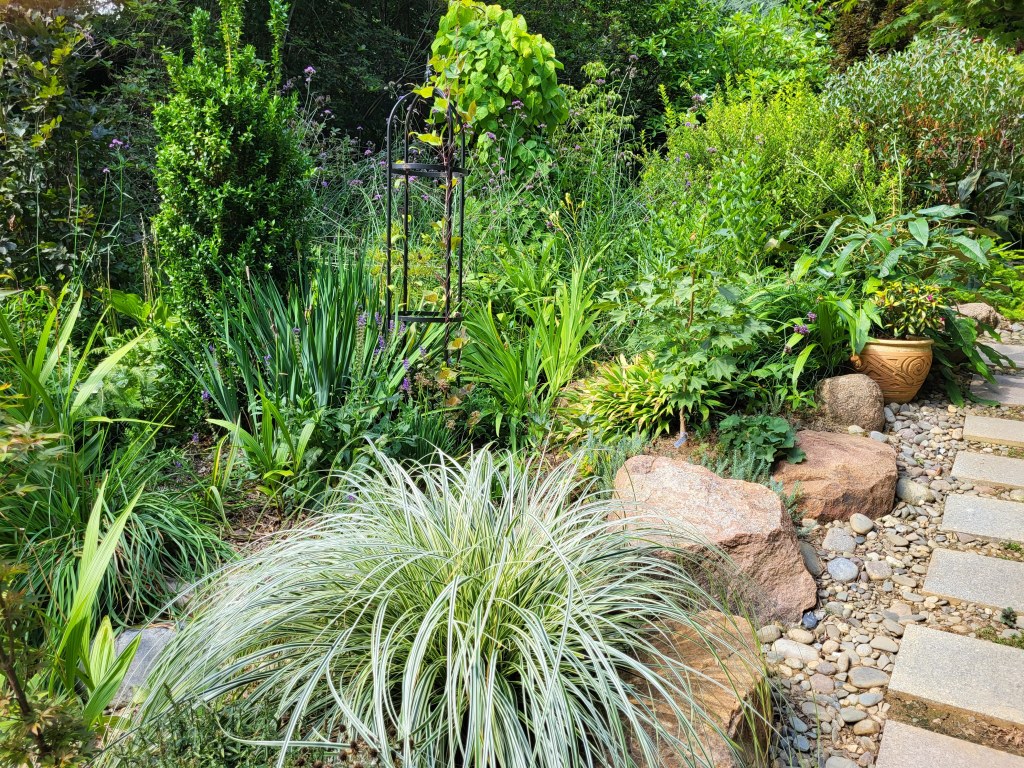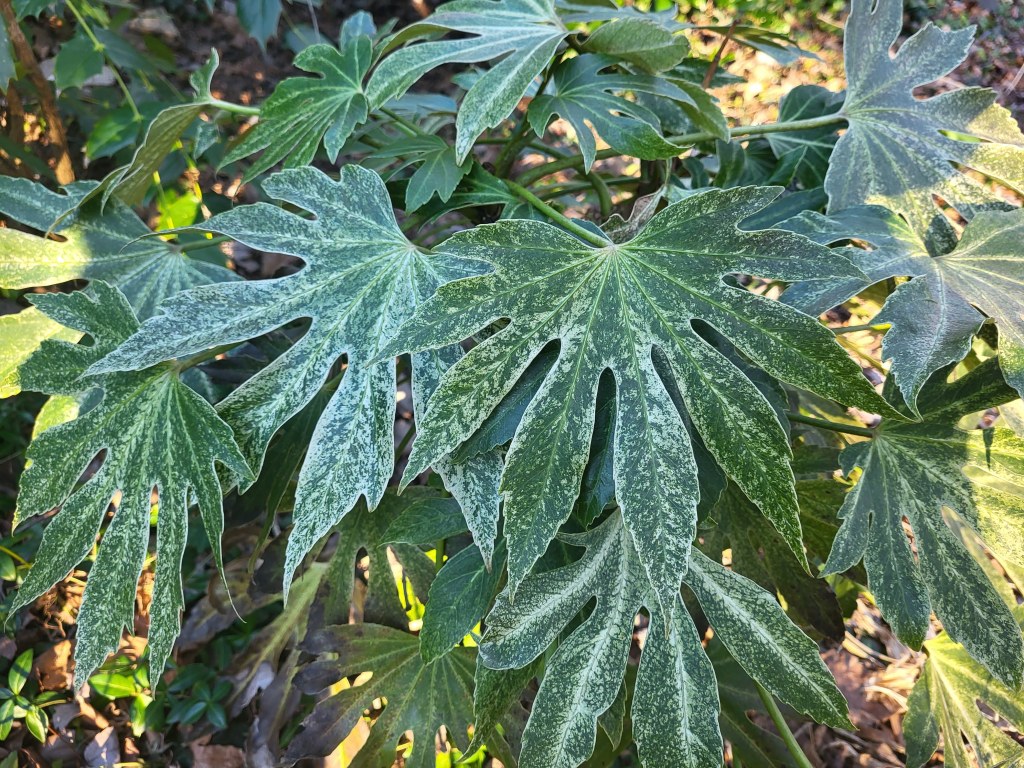First, I am not anxious for the weather to turn cold. I’ll gladly suffer through the high nineties rather than the chill of winter, but beyond the cold I prefer the fullness of the garden today rather than the comparative emptiness of the winter months. Funny, every year I wander the garden in February trying to figure how I can fill the gaping holes. Today, I wonder how I can keep everything chopped back and happy instead of neighbors flopping over one another.

In any case, how marvelous to be working in the garden this evening, not dripping in sweat. I sweated through the first half of the project to rip out the long established plants just below the deck to make room for its demolition and building the new sunroom. Barbara convinced me to hold off on carting heavy stone steps and wall stones to the back to stash for some future project. Now, with temperatures twenty degrees cooler, I’m happy to move them. Well, I’d just as soon have someone else do the heavy lifting, but it will sure be a lot easier when it’s not so hot.
Along with cooler weather, we got a bunch of rain over the weekend. Many suffering plants had hardly a drop of moisture in a month, and rain has been slack since mid spring. I don’t know how much rain fell, but it was plenty, and while much of this kind of rain runs off there was enough that wilting plants revived overnight. Still, I’d be happy with more.
At least, I’m not walking through the garden wondering how much longer one plant or another will survive. Remarkably, few plants showed signs of stress during our drought, but now my garden wandering is much happier, focusing on flowers and not on what might go wrong.

A few plant deliveries have arrived and a few more are scheduled for next week. There are some fill-ins for open spaces in the rock garden (above). A few rock garden plants didn’t make it. I assume our combined heat and humidity doomed them since many will take high temperatures in their native habitat, but these are areas that typically cool down overnight. There are multiple factors that determine plant success, and clearly the overly warm nighttime temperatures that accompany humidity can be a problem.

There’s still much I need to figure out in the rock garden, and while a few plants that perished might get a second try, my summer travels inspired me to try others. Most of the rock garden has been very successful, but now I need to tweak the few weak spots. These are mostly very small plants at the start, so they need a bit of care after planting that I’m not particularly good at. Planting in autumn should be ideal, and then we’ll see if I’ve stretched anything too far to make it through the winter.

I’ve ordered a few unusual plants for the new area by the sunroom. The plan is to make this a favored part of the garden, and with the first plantings along the edge (while still leaving room for the construction) I’m happy with the start. Once deliveries are made there are a few details to work out. Do I plant zone 8 cold hardy plants or hold them in the greenhouse or indoors for the winter?
It’s usually a bad idea to plant marginally cold hardy plants in the autumn when they can’t establish a root system before the cold. I’m usually tempted to plant them and do something to protect them if an oddball cold spell is forecast. Years ago, I would never consider such a thing, but recent mild winters are changing how and what I plant.

As always, I’m in a hurry for the newly planted area to fill in. If asked, I’d say the process should take three years, but that doesn’t work for me. Yes, it will be five years before the ‘Moonrise’ Japanese maple makes a big impact, but it’s pretty good size from the start so it doesn’t look awkward. There are a few new geraniums that I haven’t tried before that should jump in growth in the spring, and I’m anxious to see how beesia (Beesia deltophylla, above) grows as a ground cover beneath the maple. I’ve admired it in a few gardens I’ve seen, and wondered why it’s not more commonly available. I’ll soon find out.
Here in NH the 20 degree drop is respite from this summer’s heat and humidity and my plants all need a good division and trimming after all of the rain that was just relentless I say this as a new tropical systems appears for the south all the way to NY and Jersey I for one do not need it to include those of us here in New England as we are about to be swamped by yet another season TOURIST to come take in our fall foliage lol Have a great weekend for us next week 60’s daytime and 40’s at night.
We’re looking at a chance for well needed substantial rainfall this weekend. Our trees started turning several weeks ago, unfortunately to yellow due to drought.
😦 and ours may topple over as their feet are too wet with a good stiff wind some will lose the fight.
Our house closely borders the forest, though we have been fortunate in our thirty-four years to have falling trees graze the house but do no damage. Besides thunderstorms and the occasional tropical storm, our biggest threat is ice since we are often slightly too warm for snow.
I think we may be in that boat by the look of the last few winters than bam we get 100+ inches of snow then the melting and refreezing here I could rent it out as a skating rink. We are on the seacoast of NH where Massachusetts and Maine are our closest neighbors. Our coastline is just 18 miles long.
Despite our recent mild winters and lack of snow, local folks talk about heading south. It’s likely folks in your area consider us the south. I enjoy the seasonal change, for about a month, then I’m ready for spring.
I am one who loves VA BCH and Carolinas but as much as I hate moving the snow, I have time to rest and dream about gardens and what to add come spring if I have not yet added it all in the fall. I also paint watercolors all winter and read and blog so if I need a vacation, I head south for a long ride in the car but usually it is February when I have had enough of winter with March bringing up the spring bulbs it is something I would not want to miss had I run to the south for more than a week 🙂
Where did you order the beesia? (“Still, I’d be happy with more [raiin].” I think you’ll get that tomorrow…)
I ordered beesia from two nurseries. Three very good plants were sent by Sebright Gardens in Oregon.